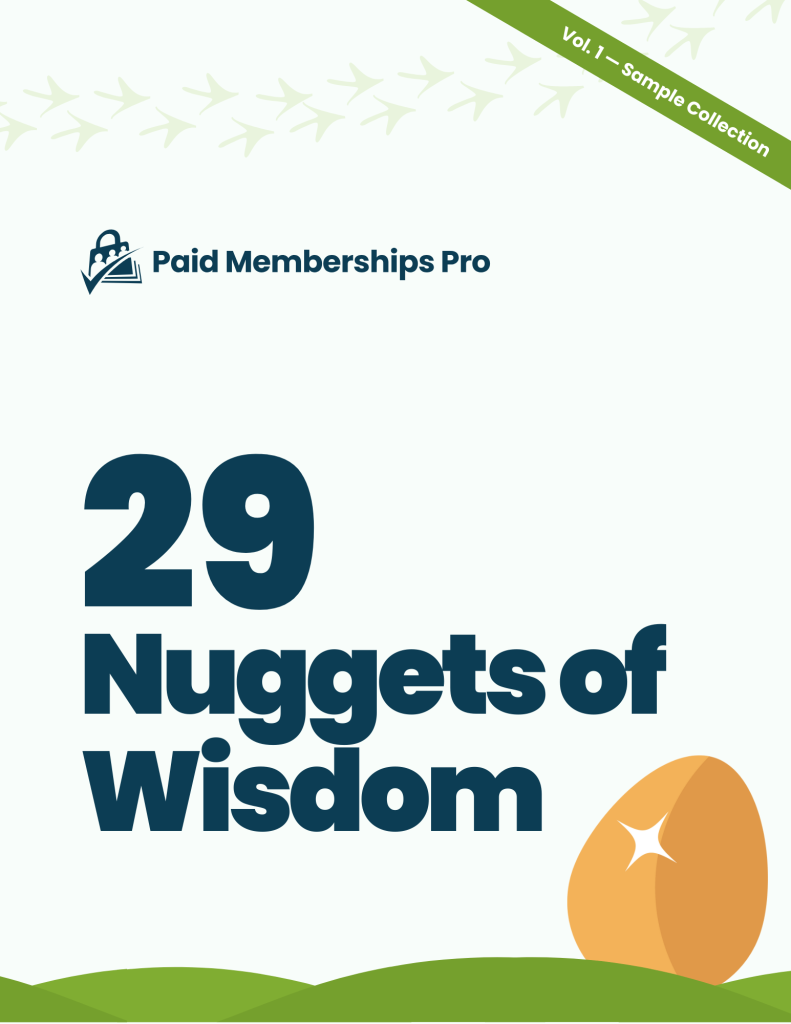If you’re thinking about starting your own membership site, or you’re already in the process of building a membership site, you’ve probably encountered a fair amount of new words and phrases.
While Google might help with basic definitions, you should understand membership site terminology on a deeper level if you want your membership business to be a success.
In this post, we list some of the most important and commonly-used membership site terms to help you get up to speed.

Table of contents
- Automation
- Buyer Persona
- Churn
- Content Strategy
- Conversion
- Customer Lifetime Value (CLV)
- Drip Content
- Email Marketing
- Engagement
- Freemium
- Gamification
- Key Performance Indicators (KPIs)
- Member Community
- Member Directory
- Member Experience
- Member Journey
- Member Onboarding
- Membership Levels (Membership Tiers)
- Membership Platform
- Membership Plugin
- Minimum Viable Product (MVP)
- Payment Gateway
- Premium Content
- Recurring Payments
- Recurring Revenue
- Retention
- Social Proof
- Subscription Fatigue
- Trial Membership
Membership Site Terminology 101
Automation
Running a membership site takes a lot of work, but automation is a way to lighten the load. By technical definition, automation refers to letting technology do the work in place of human effort.
For example, you can automate the process of sending marketing emails to your members by writing them in advance and scheduling their delivery with services like ConvertKit and MailChimp.
We wrote a post about how to automate WordPress, as well as one about how to automate your membership site with Zapier if you’re looking for more ideas.
Buyer Persona
With any type of business, it’s crucial to have an understanding of who your target audience is. A buyer persona is a fictional representation that illustrates the demographics, skills, interests, problems, needs, and wants of your ideal customer.
Churn
Losing members comes with the territory when you run a membership site. Churn refers to these lost members, and “churn rate” refers to the average percentage of members you lose over a given period of time.

DOWNLOAD NOW
Download the free ebook: Membership Site Terminology From A to Z. Get clear and concise definitions for the most common membership site terminology out there so you can navigate the world of membership businesses with ease.
Content Strategy
Many membership sites depend on the regular release of content in order to keep their members happy. Developing a content strategy helps you plan out the content you’re going to release, including things like:
- The rate at which you release content
- Topics you will cover
- Your search engine ranking goals
- User behavior goals
Conversion
Conversion refers to when a site visitor completes a desired action, such as making a purchase, or signing up for your mailing list. As a membership site owner, you probably want people to purchase your membership, for example.
Customer Lifetime Value (CLV)
Because of the ongoing nature of memberships, the value that each member provides your business over time is particularly helpful information. Customer Lifetime Value (CLV)—or Member Lifetime Value (MLV)—is the amount of revenue generated by your member over the entire course of their membership.
For example, if your members stay with you for an average of 6 months and they pay a membership fee of $20 per month, your CLV would be $120.
Drip Content
Often, membership sites create batches of content and then release this content slowly over time at regular intervals. This is referred to as drip content.
Email Marketing
Communicating with your members is important, and email marketing is one of the best ways to stay in touch with your audience and promote your membership products and services.
For example, email marketing often comes in the form of informative newsletters with calls-to-action and promotional emails for new products, content, special deals, sales, and events.
Engagement
One of the most important elements of running a membership site is user engagement, or how much users interact with your content and come back to your site on a regular basis. Because the goal is to get members to keep paying you every month, it’s essential that they stay engaged and interested in what you have to offer.
Freemium
One very popular business model for membership sites is the freemium model. This model typically involves a basic version of a product or service that members can use for free, with optional paid access to additional content or more advanced features.
We wrote a post that talks more about about how to set up a membership site for free members only.
Gamification
Integrating game-like elements into the member experience is called gamification. With membership sites, this can be things like points and rewards, member leaderboards, badges, timers, and other interactive elements designed for exploring and completing content.
Key Performance Indicators (KPIs)
As with any business, it’s important to measure the performance of your membership site and content. Key performance indicators (KPIs) are measurable factors that help you determine if your membership business is doing well or not.
Common KPIs for membership sites include:
- Website Traffic
- Conversion Rate
- Customer Lifetime Value (CLV)
- Churn Rate
- Monthly Recurring Revenue (MRR)
- Member Acquisition Cost
- Member Engagement
Member Community
Creating a member community for your membership site is one of the best ways to encourage engagement and nurture an ecosystem around your content. This can include a discussion forum, chat feature on your site, a Facebook group, or some other combination of communication elements.
Member Directory
Depending on the type of membership business you are creating, you may decide to create a member directory—a page or section of your membership site that displays a list of your members.
Member Experience
How people experience your membership is called the member experience, and it’s the key to running a successful membership site. The member experience includes things like how easy it is to use your website, how enjoyable being a member is, and how relevant, effective, and/or helpful the content is.
Member Journey
The journey that a member takes through your content is called the member journey. Depending on the type of membership site and the nature of your content, there may be more than one possible member journey—for example, beginner, intermediate, or advanced.
Member Onboarding
Member onboarding is the process of helping your members get up and running with your membership. This gives them a good initial member experience and increases the chances that they will remain loyal to your membership site.
Check out our post on how to offer presales and onboarding calls for your members to learn more.
Membership Levels (Membership Tiers)
The different packages of features and content that you offer your customers are called membership levels. They define what your customers receive, when they receive it, and what price they are charged.
Membership levels are also referred to as membership tiers.
Membership Platform
A membership platform is an all-in-one solution for creating a membership site. Membership platforms tend to have a lower barrier to entry, but higher prices and more limitations when it comes to customization.
Membership Plugin
A membership plugin is a type of software that can be installed on a website such as a WordPress website in order to add membership functionalities like recurring payments and content restriction. Membership plugins allow for a greater degree of customization, flexibility, and scalability over time as your membership grows.
Minimum Viable Product (MVP)
Before committing to building a full membership site, you can test your membership site idea with a minimum viable product (MVP). This allows you to gauge the potential return on your investment, determine the right prices for your membership site, and minimize your risk at the same time.
Payment Gateway
A payment gateway (or payment processor) processes online transactions, sending payment data from the customer’s credit or debit card to your bank as the membership site owner. Examples include Stripe and PayPal.
Premium Content
Content that you reserve for paying customers only, or content that is particularly high-value and priced higher than your standard content is known as premium content. Premium content is an effective avenue for generating membership revenue, incentivizing upgrades, and piquing the interest of prospective customers.
Recurring Payments
Membership businesses are structured around receiving recurring payments, or payments that are made at regular intervals. Recurring payments are typically charged on a monthly or yearly basis, for example.
Recurring Revenue
The revenue that you receive as the membership site owner from your customers’ recurring payments is your recurring revenue. Often, recurring revenue is measured monthly—Monthly Recurring Revenue, or MRR—and is calculated as an average amount of revenue generated on a monthly basis.
Retention
Membership businesses thrive on member retention, or keeping members as paying customers on an ongoing basis. Just like churn represents members lost, retention represents members who stay loyal to your membership.
Membership marketing, content, and user experience strategies are focused on specifically improving member retention.
Social Proof
Social proof refers to the community’s use and approval of your company or product, especially by peers of your target audience. Testimonials and social media posts that vouch for the legitimacy, quality, or effectiveness of your membership are forms of social proof that can help influence potential customers to purchase.
Subscription Fatigue
With so many subscription-based products and services on the market, customers may start to experience subscription fatigue—or, the exhaustion that comes with paying for too many subscriptions. This feeling can influence customers to start reducing the number of subscriptions they have.
Our post about how to deal with subscription fatigue highlights some strategies to consider if you want to curb this potential problem.
Trial Membership
A trial membership is often a free membership level with only the most basic features, or a limited time period when prospective members can try out the membership for free. Either way, trial memberships are designed to let people experience your membership first-hand, which can influence them to pay or upgrade later.
Time to Put Your New Knowledge to Use
Now that you have a handle on the basics of membership site terminology, it’s time to get your membership site up and running. Get Paid Memberships Pro now and start building the exact membership site you need—whether you create online courses, or manage an association, community, or paid newsletter.


